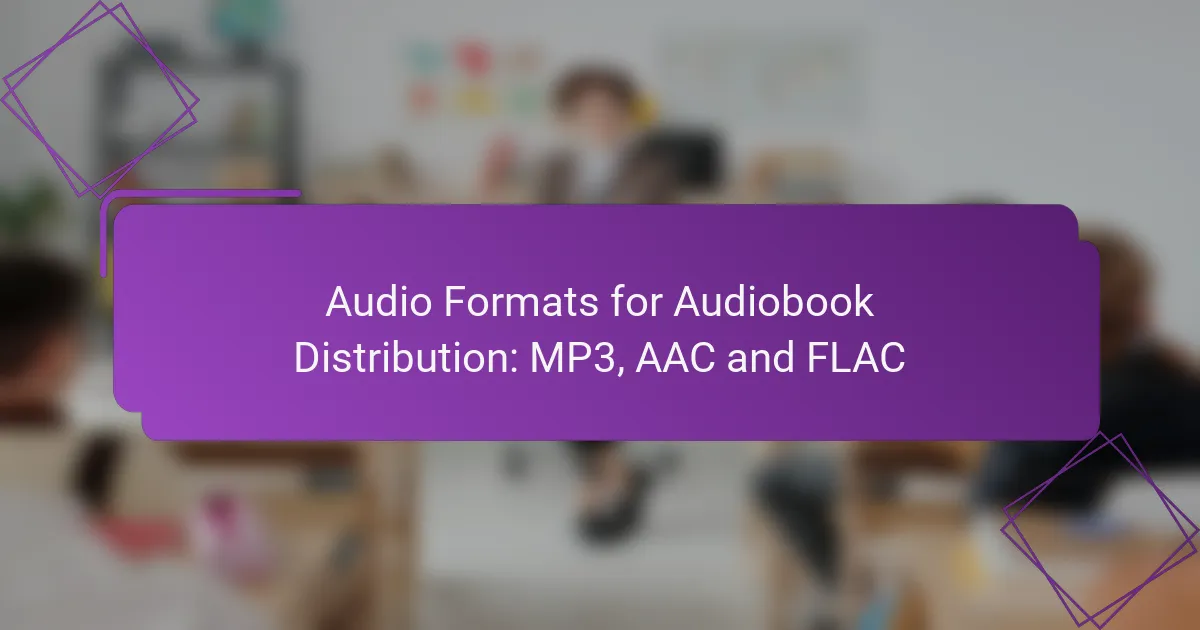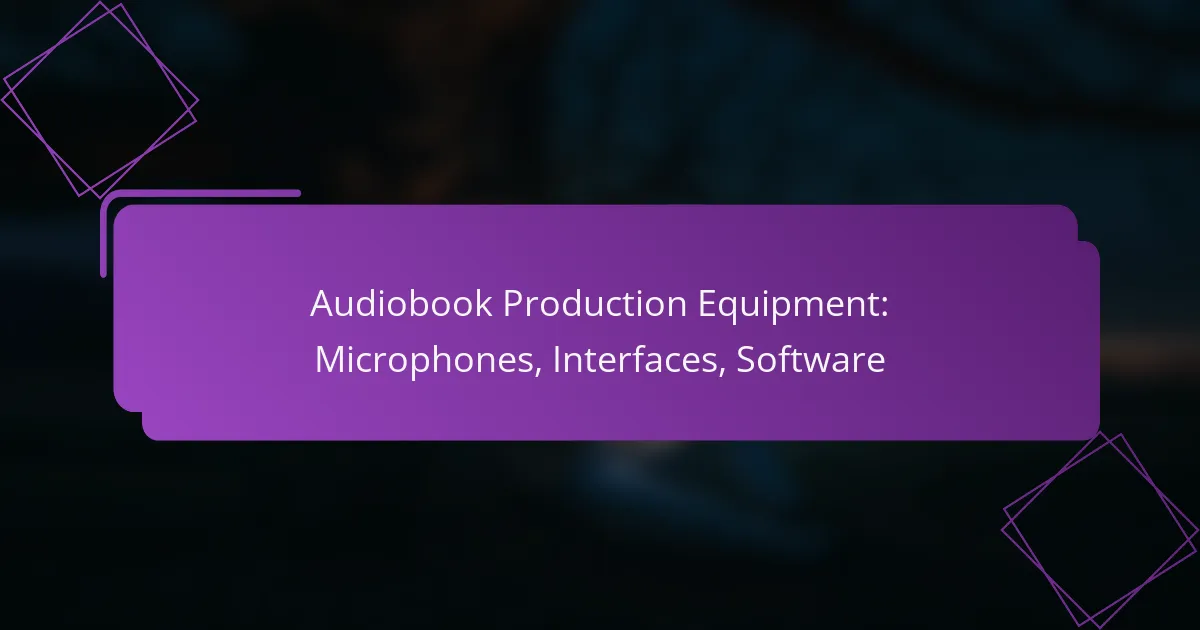Audio quality standards are essential for ensuring that audio content adheres to specific technical and performance criteria, promoting consistency and clarity across various platforms. By regularly assessing equipment and following industry benchmarks, organizations can maintain high audio fidelity while meeting regulatory requirements. Implementing best practices, such as using high-resolution formats and optimizing playback systems, further enhances the listening experience and fosters customer satisfaction.
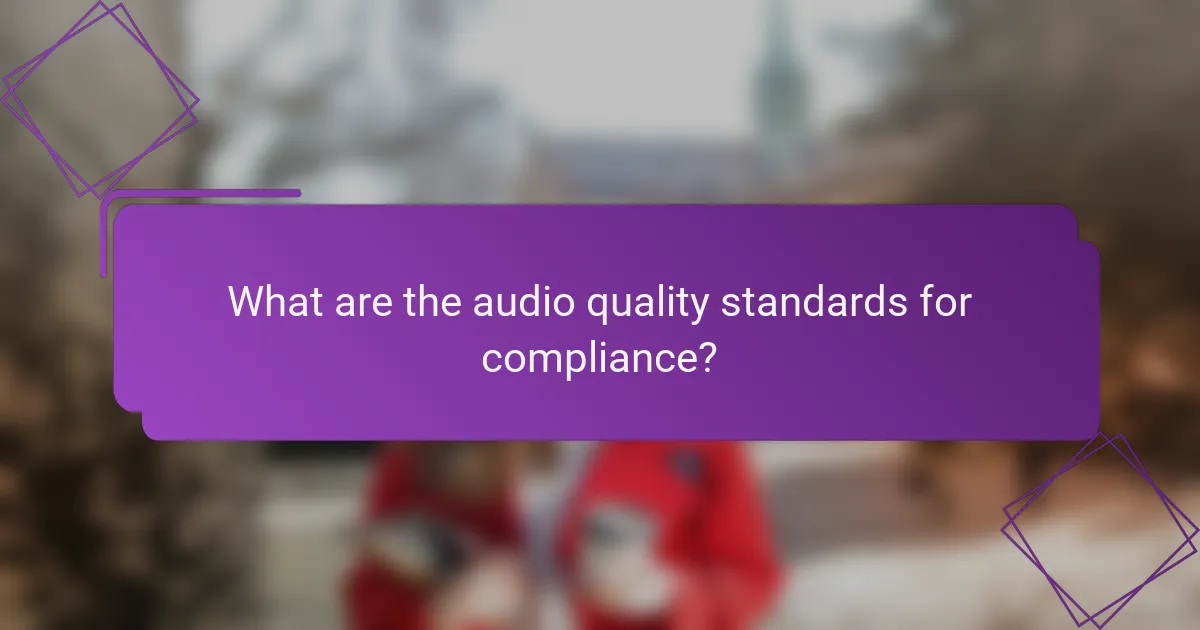
What are the audio quality standards for compliance?
Audio quality standards for compliance ensure that audio content meets specific technical and performance criteria. These standards help maintain consistency, reliability, and clarity in audio transmission and playback across various platforms and devices.
International Telecommunication Union (ITU) standards
The International Telecommunication Union (ITU) sets global standards for telecommunications, including audio quality. Key ITU recommendations, such as ITU-T P.800, outline methods for measuring speech quality, focusing on parameters like clarity and intelligibility.
When implementing ITU standards, consider the target audience and the medium of transmission. For example, standards may differ for mobile communications compared to broadcasting. Regular testing and adherence to these guidelines can significantly enhance user experience.
Audio Engineering Society (AES) guidelines
The Audio Engineering Society (AES) provides guidelines that focus on the technical aspects of audio production and reproduction. AES standards cover various topics, including digital audio formats, loudness levels, and signal processing techniques.
For compliance with AES guidelines, audio engineers should prioritize maintaining dynamic range and minimizing distortion. Utilizing tools like loudness meters and spectrum analyzers can help ensure that audio meets the recommended specifications, particularly for music and broadcast applications.
Federal Communications Commission (FCC) regulations
The Federal Communications Commission (FCC) regulates audio quality standards in the United States, particularly for broadcast and telecommunications services. Compliance with FCC regulations ensures that audio content is accessible and meets specific technical requirements.
Key FCC regulations include guidelines on loudness levels and signal quality for radio and television broadcasts. Broadcasters should regularly review their compliance status and implement necessary adjustments to avoid penalties and ensure quality transmission.
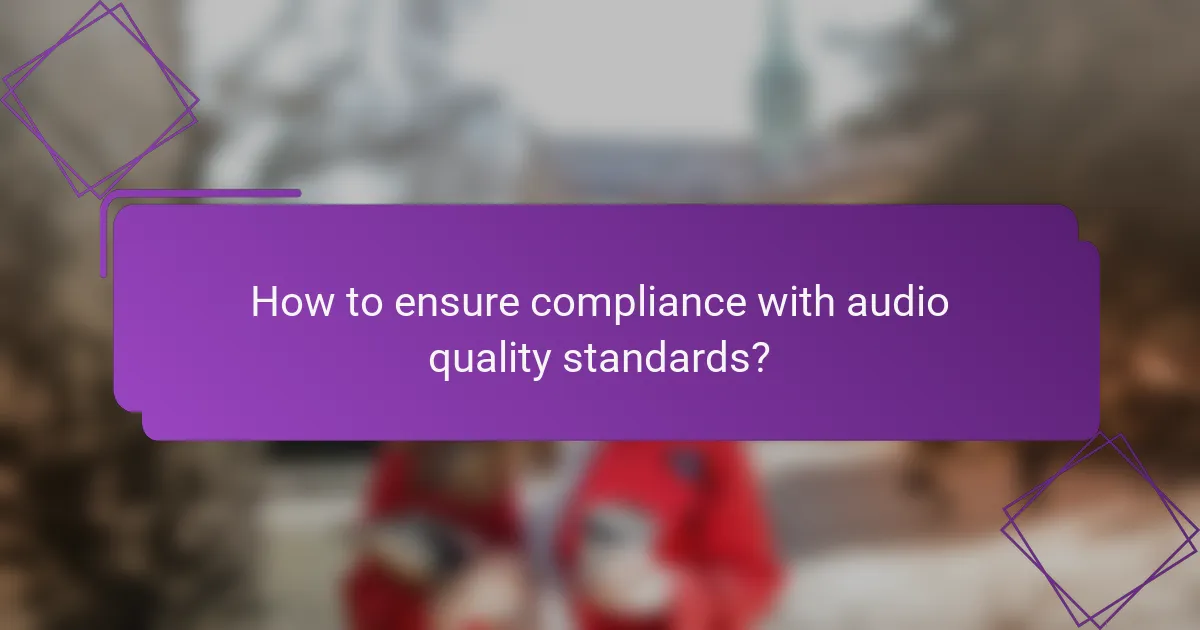
How to ensure compliance with audio quality standards?
To ensure compliance with audio quality standards, regularly assess and adjust your audio equipment, follow established industry benchmarks, and implement robust quality control processes. These steps help maintain high audio fidelity and meet regulatory requirements.
Regular equipment calibration
Regular calibration of audio equipment is essential for maintaining sound quality. This involves adjusting and testing devices like microphones, mixers, and speakers to ensure they operate within specified parameters. Aim for calibration at least every six months or more frequently in high-use environments.
Utilize calibration tools such as sound level meters and frequency analyzers to check performance. Keeping a log of calibration dates and results can help track equipment reliability and identify any recurring issues.
Adherence to industry benchmarks
Adhering to industry benchmarks is crucial for ensuring audio quality. Familiarize yourself with standards such as AES (Audio Engineering Society) and ITU (International Telecommunication Union) guidelines, which outline acceptable audio parameters. These benchmarks provide a framework for evaluating sound quality across different applications.
Regularly review and compare your audio outputs against these standards. This practice not only helps in meeting compliance but also enhances the overall listening experience for your audience.
Implementation of quality control processes
Implementing quality control processes is vital for maintaining audio standards throughout production. Establish a checklist for audio quality checks that includes aspects like clarity, volume levels, and frequency response. Conducting these checks at various stages of production can help catch issues early.
Consider using software tools for automated quality monitoring, which can flag deviations from set standards in real-time. Regular training for staff on quality control practices can also improve adherence to audio quality standards.

What are the best practices for audio quality in e-commerce?
To ensure high audio quality in e-commerce, focus on using high-resolution audio formats, optimizing playback systems, and applying effective compression techniques. These practices enhance the listening experience, which can lead to better customer engagement and satisfaction.
High-resolution audio formats
High-resolution audio formats, such as FLAC and WAV, provide superior sound quality compared to standard formats like MP3. These formats retain more detail and dynamic range, making them ideal for music and audio products sold online.
When selecting audio formats, consider the target audience’s playback devices. Many modern devices support high-resolution formats, but it’s essential to balance quality with file size to ensure quick loading times on e-commerce platforms.
Optimized audio playback systems
Optimizing audio playback systems involves ensuring that the audio files are compatible with various devices and browsers. This includes using adaptive streaming technologies that adjust audio quality based on the user’s internet speed.
Test audio playback across different platforms and devices to identify any issues. Providing users with options, such as audio quality settings, can enhance their experience and cater to different preferences.
Effective audio compression techniques
Effective audio compression techniques help reduce file sizes without significantly compromising quality. Techniques such as variable bitrate (VBR) encoding can optimize audio files for faster loading while maintaining acceptable sound fidelity.
When compressing audio, aim for a balance between quality and size. A common guideline is to keep the bitrate between 192 kbps and 320 kbps for optimal results in most e-commerce applications. Always test the final output to ensure it meets quality standards before uploading.
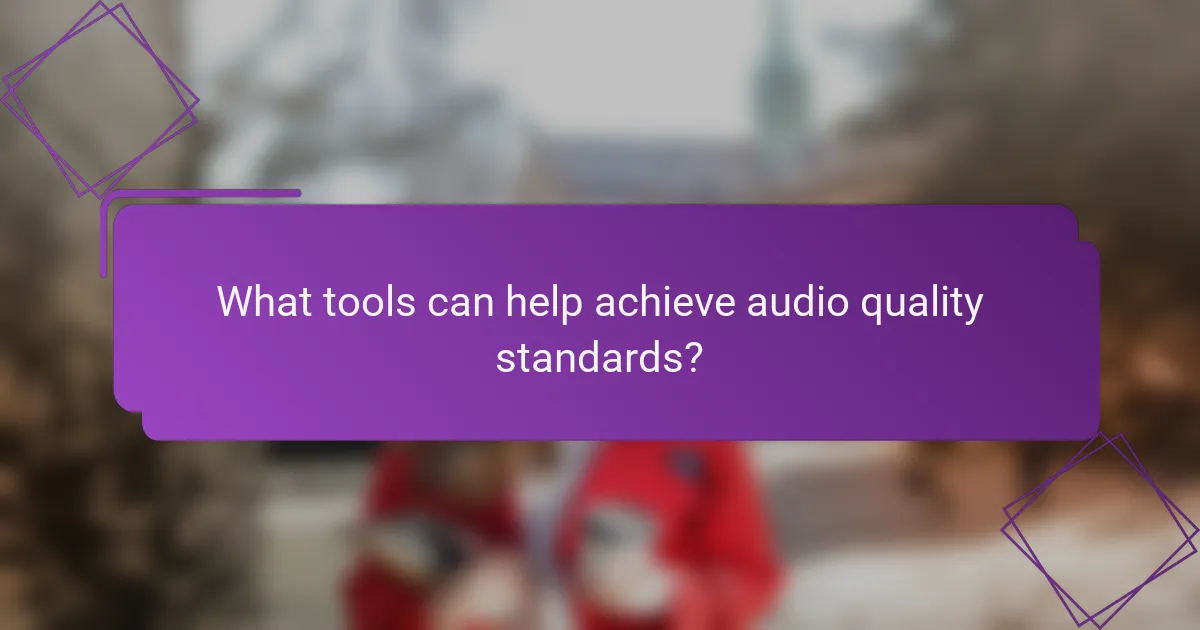
What tools can help achieve audio quality standards?
To achieve audio quality standards, several tools can assist in monitoring, analyzing, and refining sound. These tools include audio analyzers, digital audio workstations (DAWs), and sound level meters, each serving a unique purpose in the audio production process.
Audio analyzers like Smaart
Audio analyzers, such as Smaart, are essential for measuring and analyzing sound quality in real-time. They provide detailed insights into frequency response, phase correlation, and other critical parameters, helping engineers identify issues and optimize audio performance.
When using an audio analyzer, focus on key metrics like the frequency response curve and the overall sound pressure level (SPL). Regularly calibrating the equipment ensures accurate readings, which can significantly enhance the final audio output.
Digital audio workstations (DAWs) like Pro Tools
Digital audio workstations (DAWs) like Pro Tools are crucial for recording, editing, and mixing audio. They offer a range of tools and plugins that help maintain audio quality throughout the production process, allowing for precise control over sound elements.
When selecting a DAW, consider factors such as compatibility with your operating system, available plugins, and user interface. Pro Tools, for instance, is widely used in professional settings due to its robust features and industry-standard capabilities.
Sound level meters for monitoring
Sound level meters are vital for monitoring audio levels and ensuring compliance with industry standards. They measure the intensity of sound in decibels (dB) and help prevent distortion or clipping during recording and playback.
For effective use, familiarize yourself with different types of sound level meters, including analog and digital options. Aim to keep audio levels within recommended ranges, typically between -12 dB and -6 dB for optimal clarity and headroom.
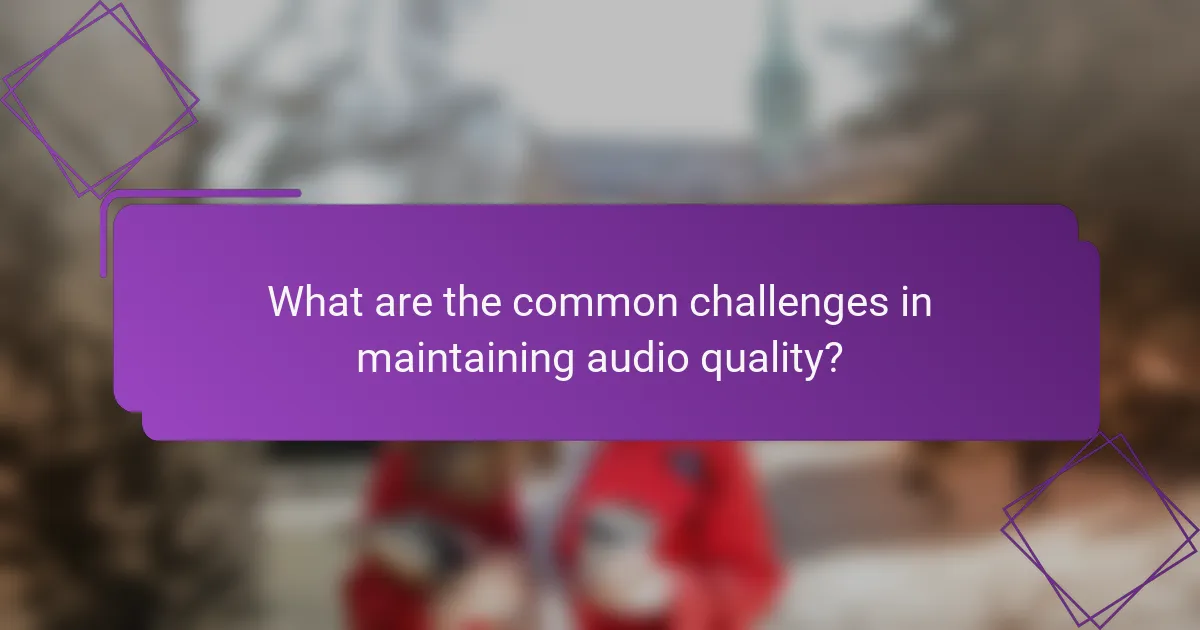
What are the common challenges in maintaining audio quality?
Maintaining audio quality involves several challenges that can affect clarity, consistency, and overall listener experience. Key issues include environmental noise interference, equipment compatibility, and inconsistent audio formats.
Environmental noise interference
Environmental noise interference occurs when external sounds disrupt audio clarity. This can include background chatter, traffic noise, or mechanical sounds from equipment. To minimize these disruptions, consider using soundproofing materials and selecting quieter environments for recording.
Additionally, employing directional microphones can help focus on the intended sound source while reducing unwanted noise. Regularly assessing the recording environment is crucial to identify and mitigate potential noise sources.
Equipment compatibility issues
Equipment compatibility issues arise when different audio devices do not work well together, leading to degraded sound quality. This can happen with mismatched audio interfaces, microphones, or playback systems. Always check specifications and ensure that devices support the same audio formats and sample rates.
Using standardized equipment, such as those adhering to common industry standards like AES/EBU or S/PDIF, can reduce compatibility problems. Regular updates and maintenance of equipment can also enhance performance and reliability.
Inconsistent audio formats
Inconsistent audio formats can lead to playback issues and quality loss. Different formats, such as MP3, WAV, or AAC, may have varying compression levels and sound fidelity. It is essential to choose a consistent format for recording and distribution to maintain audio quality.
When converting audio files, use high-quality settings to preserve clarity. Familiarize yourself with the pros and cons of each format to select the best one for your specific needs, keeping in mind factors like file size and compatibility with playback devices.

